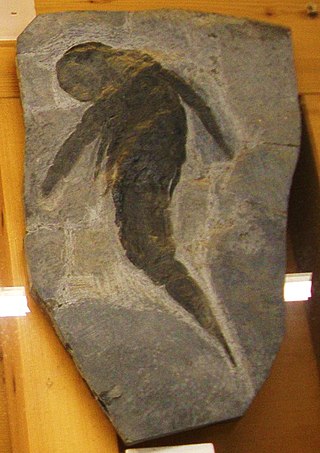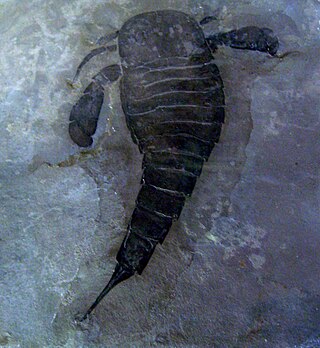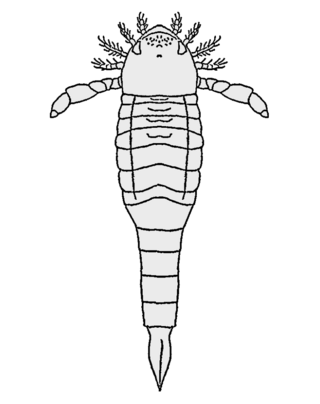
Pterygotus is a genus of giant predatory eurypterid, a group of extinct aquatic arthropods. Fossils of Pterygotus have been discovered in deposits ranging in age from Middle Silurian to Late Devonian, and have been referred to several different species. Fossils have been recovered from four continents; Australia, Europe, North America and South America, which indicates that Pterygotus might have had a nearly cosmopolitan (worldwide) distribution. The type species, P. anglicus, was described by Swiss naturalist Louis Agassiz in 1839, who gave it the name Pterygotus, meaning "winged one". Agassiz mistakenly believed the remains were of a giant fish; he would only realize the mistake five years later in 1844.

Stylonurina is one of two suborders of eurypterids, a group of extinct arthropods commonly known as "sea scorpions". Members of the suborder are collectively and informally known as "stylonurine eurypterids" or "stylonurines". They are known from deposits primarily in Europe and North America, but also in Siberia.

Brontoscorpio is an extinct genus of scorpion. Remains of the only known species, Brontoscorpio anglicus, were discovered in the St. Maughan's Formation, Lochkovian-aged sandstone from Trimpley, Worcestershire. The species was described on the basis of an incomplete single free finger of a right pedipalp (In31405), almost 10 cm (3.9 in) long. The complete animal is estimated to have been 77.2–91.5 cm (2.5–3.0 ft) long for females and 86.2–94 cm (2.8–3.1 ft) long for males, making Brontoscorpio one of the largest known scorpions. The species is characterized by the presence of single condyle and row of thick tubercles on the pedipalp free finger.

Dolichopterus is a genus of prehistoric sea scorpions, arthropods in the order Eurypterida. Fossils of Dolichopterus have been discovered in deposits ranging from Silurian to Devonian, and have been referred to several different species, some of them of dubious affinity to this genus.

Brachyopterus is a genus of prehistoric eurypterid of the family Rhenopteridae. It is one of the earliest known eurypterids, having been recovered from Middle Ordovician deposits in Montgomeryshire, Wales. Though other species have been assigned to it in the past, Brachyopterus is today recognized as containing one valid species, B. stubblefieldi.

Drepanopterus is an extinct genus of eurypterid and the only member of the family Drepanopteridae within the Mycteropoidea superfamily. There are currently three species assigned to the genus. The genus has historically included more species, with nine species having been associated with the genus Drepanopterus. Five of these have since been proven to be synonyms of pre-existing species, assigned to their own genera, or found to be based on insubstantial fossil data. The holotype of one species proved to be a lithic clast.
Salteropterus is a genus of eurypterid, an extinct group of aquatic arthropods. Fossils of Salteropterus have been discovered in deposits of Late Silurian age in Britain. Classified as part of the family Slimonidae, the genus contains one known valid species, S. abbreviatus, which is known from fossils discovered in Herefordshire, England, and a dubious species, S. longilabium, with fossils discovered in Leintwardine, also in Herefordshire. The generic name honours John William Salter, who originally described S. abbreviatus as a species of Eurypterus in 1859.

Parastylonurus is a genus of prehistoric eurypterid. It is classified within the Parastylonuridae family and contains three species, P. hendersoni and P. ornatus from the Silurian of Scotland and P. sigmoidalis from the Silurian of England.

Stylonurella is a genus of prehistoric eurypterid. It is classified within the Parastylonuridae family and contains three species, S. arnoldi and S. beecheri from the Devonian of Pennsylvania, United States and S. spinipes from the Silurian of Kip Burn, Scotland.

Strobilopterus is a genus of prehistoric eurypterid of the family Strobilopteridae. The genus contains four species, two from the Devonian of Wyoming, United States, one from the Devonian of Ohio, United States and one from the Silurian of Estonia.

Erettopterus is a genus of large predatory eurypterid, an extinct group of aquatic arthropods. Fossils of Erettopterus have been discovered in deposits ranging from Early Silurian to the Early Devonian, and have been referred to several different species. Fossils have been recovered from two continents; Europe and North America. The genus name is composed by the Ancient Greek words ἐρέττω (eréttō), which means "rower", and πτερόν (pterón), which means "wing", and therefore, "rower wing".

Stylonurus is a genus of prehistoric eurypterid of the family Stylonuridae. The genus contains three species: Stylonurus powriensis from the Devonian of Scotland, Stylonurus shaffneri from the Devonian of Pennsylvania and Stylonurus perspicillum from the Devonian of Germany.

Parahughmilleria is a genus of eurypterid, an extinct group of aquatic arthropods. Fossils of Parahughmilleria have been discovered in deposits of the Devonian and Silurian age in the United States, Canada, Russia, Germany, Luxembourg and Great Britain, and have been referred to several different species. The first fossils of Parahughmilleria, discovered in the Shawangunk Mountains in 1907, were initially assigned to Eurypterus. It would not be until 54 years later when Parahughmilleria would be described.

The Rhenopteridae are a family of eurypterids, an extinct group of chelicerate arthropods commonly known as "sea scorpions". The family is the only family currently contained in the superfamily Rhenopteroidea, one of four superfamilies classified as part of the suborder Stylonurina.

Eurypteroidea are an extinct superfamily of eurypterids. It contains three families and two genera of uncertain classification, Paraeurypterus and Pentlandopterus.
The Kokomo Formation is a geologic formation in Indiana. It preserves fossils dating back to the Silurian period, most notably sea scorpions.

Waeringopteridae is a family of eurypterids, an extinct group of aquatic arthropods. The Waeringopteridae is the only family classified as part of the superfamily Waeringopteroidea, which in turn is classified within the infraorder Diploperculata in the suborder Eurypterina. The earliest known member of the group, Orcanopterus, has been recovered from deposits of Katian age and the latest known surviving member, Grossopterus, has been recovered from deposits of Siegenian age. The name Waeringopteridae is derived from the type genus Waeringopterus, which is named in honor of eurypterid researcher Erik N. Kjellesvig-Waering.

Stoermeropterus is a genus of prehistoric eurypterid from the Silurian period in Europe and North America classified as part of the Moselopteridae family. The genus contains three species, S. conicus and S. latus from Ringerike, Norway and S. nodosus from West Virginia.

Ciurcopterus is a genus of eurypterid, an extinct group of aquatic arthropods. Fossils of Ciurcopterus have been discovered in deposits of Late Silurian age in North America. Classified as part of the family Pterygotidae, the genus contains two species, C. sarlei from Pittsford, New York and C. ventricosus from Kokomo, Indiana. The genus is named in honor of Samuel J. Ciurca, Jr., who has contributed significantly to eurypterid research by discovering a large amount of eurypterid specimens, including the four specimens used to describe Ciurcopterus itself.

This timeline of eurypterid research is a chronologically ordered list of important fossil discoveries, controversies of interpretation, and taxonomic revisions of eurypterids, a group of extinct aquatic arthropods closely related to modern arachnids and horseshoe crabs that lived during the Paleozoic Era.


















